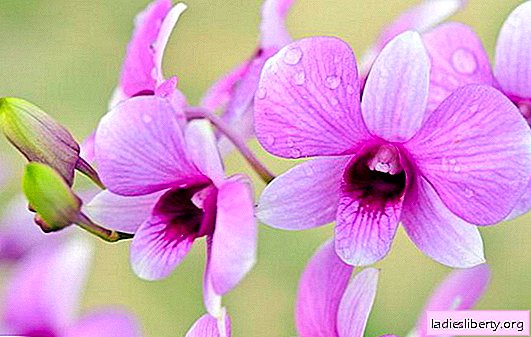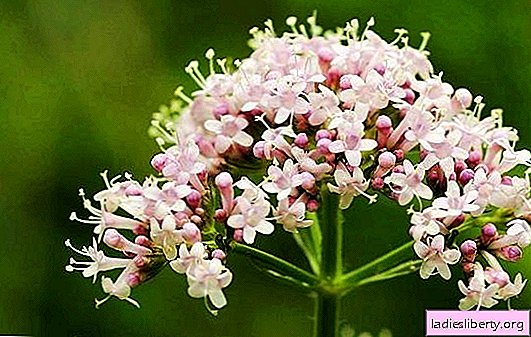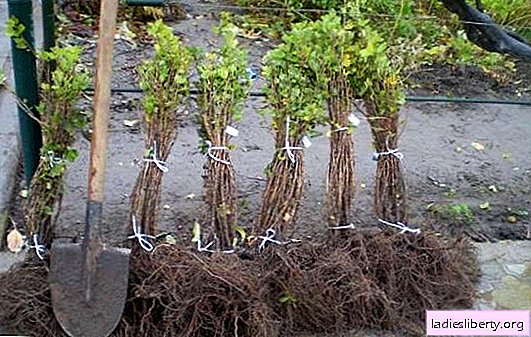
Realize the dream of having an exotic fragrant flower at home with orchids.
The dendrobium is considered the easiest to grow at home among them.
Breeders have bred a lot of hybrid forms of this species, among which the least capricious in care are nobile dendrobium or noble and phalaenopsis dendrobium.
Dendrobium: home care - reproduction, transplantation
Breeding
Dendrobium can be propagated by children and division. In the first version, the baby, grown up to at least 5 cm, is cut off, the roots are moistened and placed in a half-full pot. Top up the substrate and condense, being careful not to damage the roots. The growth point is left on the surface. Be sure to put a support in the pot and fix the plant. It is not necessary to place a seedling in a greenhouse. Between waterings, spray the top layer of the substrate.

Children released roots - can be planted in separate pots
In the second method, pseudobulbs are separated from the mother plant, cut into cuttings with 2-3 nodes (about 10 cm long), put them on moist sphagnum and placed in a bag or in a greenhouse.

Rooting of dendrobium cuttings in sphagnum
In such hotbeds, the temperature is maintained at + 20-25 ° C, the cuttings are aired and moistened daily. When they take root (after 14-20 days), they are planted in pots with a substrate.
Transfer
Dendrobium does not like annual relocation. It is transplanted every 3 years in the event that the roots become very cramped or the substrate pH has changed (norm 5.5-6.5). It is not recommended to take a new pot too large: its diameter is selected 2-3 cm larger than the size of the previous one. Dendrobium is placed for 10-15 minutes in a solution of succinic acid (1 tablet per 1 liter of warm water). After saturation of the roots with moisture (they will become a greenish-milky color), the plant is taken out and left to dry for half an hour on a towel. Then it is placed on a substrate in a pot so that the old pseudobulbs are closer to the edge. The root neck is left on the surface. The roots are straightened, the spaces between them are filled with bark. After transplanting, you do not need to water the flower immediately - the wounds on mechanically damaged roots must heal. The waiting time for watering depends on the size of the roots and ranges from 3 to 14 days.
Dendrobium home care - substrate, lighting, flowering conditions
Substrate
Pine bark is used as the main ingredient of the substrate for growing dendrobiums. The size of the pieces of bark should be average so that in a couple of days the entire volume of the substrate in the pot has time to dry out. Add moss or peat is not worth it, because this leads to waterlogging of the roots and their decay. It is better to add a handful of charcoal per 1 liter of bark. For drainage, it is good to use crushed polystyrene, pebbles. Expanded clay should not be taken: it is able to accumulate salts in itself, which have a negative effect on the root system of the orchid.
Lighting
Like any tropical plant, dendrobium needs bright diffused lighting, but without frontal sunlight. At home, in the autumn-winter season, the orchid is kept on the southern window sills or use additional illumination with phytolamps of daylight. With a lack of lighting, the shoots of orchids are bent, the number of flower buds being laid is reduced. In spring and summer, it is better to rearrange it on the western or eastern windows. If the flower is on the south side, then in the afternoon it should be shaded.
Temperature and humidity
In the phase of active growth and flowering, the optimum temperature for this type of orchid will be the range + 22-28 ° C. In autumn and winter, hybrids of dendrobiums phalaenopsis and nobile can be kept at room temperature + 18-20 ° C. In this case, watering should be limited or replaced by spraying the substrate every two to three days.
Like all epiphytic plants, dendrobium needs high air humidity (65-70%). However, hybrid dendrobiums grow well and bloom even at 40-50%. At home, you can use special humidifiers for this, regularly spray the orchid, put sphagnum in a pot or put the pots in a tray with wet sand, pebbles.
Important! Dendrobiums should be sprayed early in the morning or in the evening. Otherwise, drops of moisture, focusing like lenses on the sun's rays, will cause burns to the leaves.
Conditions for flowering dendrobium
In order for the dendrobium to bloom at home, it is necessary to observe several factors: top dressing and watering must be stopped, the difference between day and night temperatures should be 7-10 ° C. In summer, this happens naturally, and in winter you will have to try: the night air temperature in the room should be at + 12-15 ° C. If you keep the orchid all the time at elevated temperatures, then the flower buds are reborn into "children." It is important to provide additional illumination with luminescent phytolamps - with a lack of lighting, the number of flower buds decreases sharply.
When new shoots have roots on the mother plant, you can start watering again. As soon as the new growth “catches up” the old bulbs, watering is stopped until the buds appear. From the period when they began to blossom, watering is resumed.
You can stimulate the dendrobium to bloom by sending it in the summer to "walk" outside the room (onto a balcony, a loggia, a garden, a terrace). In the fresh air, you should provide the orchid with a place that is protected from the wind and direct insolation. After 2 weeks of this content, the dendrobium produces peduncles.
Dendrobium home care - top dressing and watering
Top dressing
Dendrobiums and their hybrids are fed during active growth every 2 weeks with special fertilizers for orchids. The concentration is taken half as much as indicated on the package. This flower can be fed both by leaves and under the root. Fertilize half an hour after watering with one of the options:
• spraying;
• Immersion of a pot of orchid in a nutrient solution.
When the dendrobium blooms, then there is no need to feed. However, if during this period there is an increase in new or thickening of old pseudobulbs, then additional nutrition is necessary.
Important! You can fertilize only healthy orchids.
Watering
Irrigation regimen depends on the period of the dendrobium life cycle. In the period of intensive growth, the orchid is often and abundantly watered. Watering can be by surface method and by immersion.
If splashes of water get into the axils of the leaves, then the liquid must be removed with a napkin. Otherwise, the likelihood of rotting the fabric.
The substrate between waterings should be allowed to dry.
Important! Do not allow water to fall on the peduncles and the flowers themselves.
When the dendrobium begins to ripen pseudobulb (they stopped growing up and began to thicken), watering is reduced.
The water used for irrigation is settled or filtered; its temperature should be slightly higher than room temperature.
Dendrobium at home: why does it die?
Dendrobium most often dies with improper care. Damage to the root system occurs with such errors in care as:
• Excessive wetting of the substrate;
• Overfeeding with fertilizers;
• Dense substrate (over time, under the influence of soil fungi, it begins to collapse, caking. As a result, its breathability decreases, the roots of the orchid begin to choke and rot);
• Inadequate watering causes the root system to dry out;
• Overheating of the plant (the orchid stands close to the battery or in a sunny place, as a result of which evaporation of moisture from the substrate and the ground part is intensified, the absorption capacity of the roots decreases and they rot).
To determine the degree of damage to the root system, you need to slightly move the orchid in the pot. If she sits tight, then the roots are still alive. When eliminating errors in care, such a plant will recover quite quickly.
If the dendrobium dangles in the substrate, then it is necessary to pull it out of the pot and examine the root system: healthy roots are dense and firm, and rotten ones are brown in color, hollow, slimy. If there is at least one whole root, the plant can be reanimated.
If the dendrobium leaves become lethargic and turn yellow and die over time, this can be caused by the following reasons:
• Damage to spider mites;
• Severe tissue atrophy (with a lack of moisture);
• The root system is damaged;
Cracks in the middle of the sheet occur when:
• Mechanical damage (the plant was dropped, the leaf was bent, etc.);
• An excess of nitrogen. In this case, the dendrobium is removed from the pot, the roots from the old substrate are washed and transplanted into a new one. In the first 2-3 months after this, they do not fertilize at all, then fertilize with potash and phosphorus fertilizers. The process of restoration of an orchid can take a whole year, during which it can stop growing: for a overfed plant, this is the norm.
• A sharp hypothermia after watering - such a mistake in the winter period is made by beginning flower growers, immediately exposing the dendrobium after a shower on a cold windowsill closer to the glass
• Rare watering. She is also a typical mistake of budding orchid lovers. Fearing to flood the plant, they increase the time between watering, as a result of which the leaves lose turgor. After watering, the plant begins to consume water intensely, dehydrated tissues do not have time to take it, are deformed and burst.
Dendrobium leaves turn yellow in the following cases:
• The natural aging process;
• Defeat by diseases and pests;
• Chemical burn with fertilizers, stimulants;
• Overheating of the plant;
• Stress (relocation, lack of lighting, humidity, improper room temperature, improper watering).
The appearance on the leaves and pseudobulbs of spots of various shapes and sizes is characteristic of fungal diseases. So, with phylloctictosis at an early stage, these spots are small and yellow, gradually they merge and blacken. The sheet begins to dry out or rot (with increased humidity).

Orchid Leaf Affected by Phylostictosis
Fusarium spotting is manifested by the appearance of brown depressed points on flowers, buds, peduncles, and black with a yellow rim spots on leaves and pseudobulbs. The causative agent of this disease - a fungus of the genus Fusarium - penetrates the plant through wounds of leaves and roots. Spores of the fungus can persist for a long time in the external environment. They are easy to carry on clothes when caring for flowers. The use of fungicides will not bring the destruction of the disease 100%. Therefore, the diseased plant must be isolated from others, cut the damaged tissue and disinfect the sections. In spring or summer it is transplanted into a new substrate and pot, and the old one is thrown away.
Small watery spots on the flowers and buds are a sign of infection of the dendrobium with a fungus of the genus Botryties, which provokes the development of gray rot.

Gray rot on an orchid flower
In parallel, gray spots with ashen sporangia inside form on the leaves and pseudobulbs of the orchid. The development of this disease contributes to increased humidity and low air temperature with poor aeration in the room, overfeeding orchids with nitrogen, poor lighting. Botritis affects only weakened plants, so it is important to observe proper care for them. The diseased orchid must be immediately isolated and treated with a fungicide (Skor, Fitosporin-M, Fundazol).
Of the pests, dendrobium is damaged by scale insects and false shields, spider mites, thrips, mealybug, nematodes, and podura. To combat them, insecticides are used (Biotlin, Fitoverm, Vermitek, Aktara, Sunmayt and others).
When grown at home, dendrobium, like other types of orchids, can throw off buds and flowers. This happens due to the stress state of the plant caused by the following factors:
• A sharp change in microclimate (for example, when moving);
• Lack of lighting;
• Overheating in the sun or from heating appliances;
• Wrong watering;
• Subcooling.
Do not place dendrobiums next to a vase of fruit (especially apples, bananas, apricots), because they emit ethylene. This gas contributes to the accelerated aging of flowers and buds.











